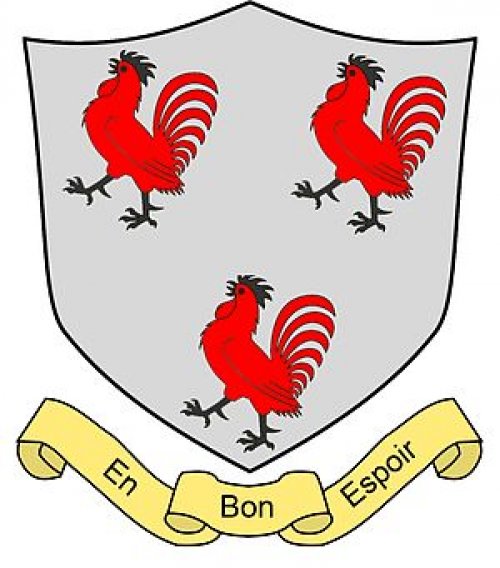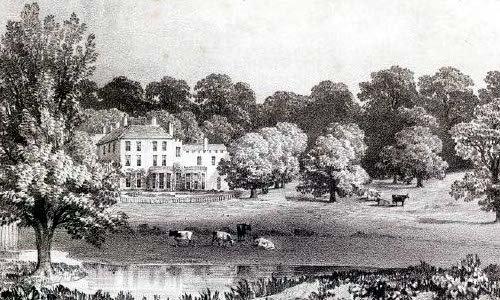Did you know that three of Henry VIII’s wives, Catherine Howard, Jane Seymour and Ann Boleyn were all great, great, great grand-daughters of Sir John Cockayne of Ashbourne.
From the latter part of the 1200s the manor of Ashbourne belonged to the Earls and Dukes of Lancaster. In 1326 their bailiff was William Cockayne. The Cockayne family gradually assumed more and more responsibilities and became de facto Lords of the Manor while serving their masters which included John of Gaunt and then the Lancastrian Kings of England.
St Oswald’s church has a fine series of tombs to the family. It covers seven out of eight generations of the family in the period 1372 to 1592. The earliest is the combined tomb for John Cockayne (d. 1372) and his son, Sir Edmund Cockayne, (d. 1403). Sir Edmund has the family coat of arms, three cockerels, carved onto his surcoat. Edmund died at the Battle of Shrewsbury in 1403, fighting for John’s son King Henry IV.
The next generation is Sir John Cockayne (d. 1447) with his wife, Margaret Longford. Sir John was the son of Sir Edmund and often confused in documents with Edmund's brother, 'Sir John' who was nicknamed 'the uncle'. Sir John was a steward to the Lancastrians and his tomb shows him wearing a SS collar. The tomb is made of Derbyshire alabaster, and is the work of the Chellaston firm of Robert Sutton and Thomas Prentys. The weeping angels round the tomb can be found on other tombs made by this firm.
Sir John Cockayne (d. 1447) had two sons called John (another source of genealogical confusion). The elder John reached adulthood and married but died without issue in his father's lifetime leaving the father without an heir. The father then remarried and had another son christened John, who inherited the estate as an infant. This Sir John Cockayne (d. 1505) married Agnes, daughter of Sir Richard Vernon of Haddon Hall.
Sir John (d.1505) was succeeded by his grandson, Sir Thomas, 'The Magnificent', d. April 1537. He married Barbara, daughter of Sir John FitzHerbert of Etwall. He was knighted by Henry VIII at the siege of Tourney in 1513, and was present at the Field of the Cloth of Gold in 1520. Sir Thomas died in 1537 and his son Francis a year later. The tomb of Francis and his wife Dorothy, daughter of Sir Thomas Marrowe, is in brass.
Francis' son, Sir Thomas, d. 1592 is the last member of the family to have a tomb in the church. Sir Thomas Cockayne married Dorothy, daughter of Sir Humphrey Ferrers of Tamworth Castle, (d. 1595). Sir Thomas took part in the siege of Leith during the war against Scotland in 1544, was the author of "Short Treatise of Hunting" and was one of the guards of Mary, Queen of Scots, during her 'stay' in Derbyshire. In 1585 he was the principal founder of the Ashbourne’s Queen Elizabeth’s Grammar School.
His grandson, the poet Sir Aston Cockayne (1607 – 1683), as a Catholic and supporter of King Charles I during the Civil War, ran up serious debts. He managed to end up in Marshalsea Prison for debt. He ended his days living in lodgings in Derby having joined with his son in selling Ashbourne Hall and other estates in 1671.
One of the grandest churches in Derbyshire, with a slender spire of 212 feet. Referred to in the Doomsday book, the present church building dates from the mid 1200's and contains fine stained glass and monuments.
In 1547 the Hall is drawn as a rambling gabled timber framed range of buildings built around a courtyard. This had clearly grown over the years and by the Hearth Tax returns of 1662 the house had 21 chimneys making it one of the largest private homes in Derbyshire. The old hall was replaced in Georgian times.
Ashbourne Park is a surviving part of a medieval deer park. It remained part of the Ashbourne Hall estate for over 800 years and was recorded as an impaled park on a map of 1547 and described in England’s oldest rhyming epitaph as one of three hunting parks created by the Cockayne family.
















